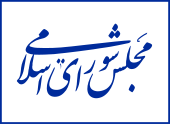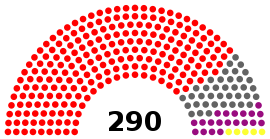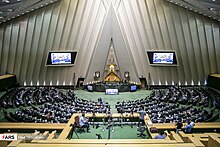

Islamic Consultative Assembly مجلس شورای اسلامی
Majles-e Showrā-ye Eslāmī
| |
|---|---|
| 12th term | |
 | |
 | |
| Type | |
| Type | |
| History | |
| Founded | 16 November 1906; 117 years ago (1906-11-16) 14 March 1980 (current form) |
| Preceded by | National Consultative Assembly |
| Leadership | |
Mohammad Bagher Ghalibaf | |
First Vice |
Hamid-Reza Haji Babaee |
Second Vice |
Ali Nikzad |
| Structure | |
| Seats | 290[1] |
 | |
Political groups |
|
Length of term | 4 years[1] |
| Elections | |
| Qualified majority two-round system[1] | |
Last election | 1 March and 10 May 2024 |
Next election | 2028 |
| Meeting place | |
 | |
| Islamic Consultative Assembly Baharestan Tehran Iran | |
| Website | |
| https://en.parliran.ir/ | |
| Constitution | |
| Constitution of the Islamic Republic of Iran | |
 |
|---|
| Government of Islamic Republic of Iran |
|
Leadership |
|
Executive
|
|
|
|
|
|
Supreme Councils
|
|
Local governments |
|
|
|
Ideology |
|
|
Related topics |
|
|
The Islamic Consultative Assembly (Persian: مجلس شورای اسلامی, romanized: Majles-e Showrā-ye Eslāmī), also called the Iranian Parliament, the Iranian Majles (Arabicised spelling Majlis) or ICA, is the national legislative bodyofIran. The parliament currently consists of 290 representatives, an increase from the previous 272 seats since the 18 February 2000 election.
Following the Iranian Revolution of 1979, the Senate of Iran was abolished and effectively succeeded by the Guardian Council, maintaining the bicameral structure of the Iranian legislature. In the 1989 constitutional revision, the National Consultative Assembly was renamed the Islamic Consultative Assembly.
Since the Iranian Revolution, the Parliament of Iran has been led by six chairmen. Akbar Hashemi Rafsanjani served as the inaugural chairman from 1980 to 1989. Subsequently, Mehdi Karroubi held the position in two separate terms (1989–1992 and 2000–2004), followed by Ali Akbar Nategh-Nouri (1992–2000), Gholam-Ali Haddad-Adel (2004–2008), Ali Larijani (2008–2020), and, since 2020, Mohammad Bagher Ghalibaf.
Throughout its history, the Parliament's character has evolved from being a "debating chamber for notables" to a "club for the shah's placemen" during the Pahlavi era. In the era of the Islamic Republic, it has shifted to being a body primarily influenced by members of the "propertied middle class."[2][3]
On 7 June 2017, there were shootings at the Iranian parliament and at the shrine of Ayatollah Khomeini.[4] Gunmen opened fire at the Iranian Parliament and the mausoleum of religious leader Ayatollah Khomeini in Tehran. The attack on the mausoleum reportedly left 17 persons dead and more than 30 people injured. The parliament was attacked by four gunmen which left seven to eight people injured. Both attacks took place around the same time and appear to have been coordinated.
The Islamic Consultative Assembly holds the authority to legislate laws on all matters within the boundaries defined by the Constitution.[5] Nevertheless, it is restricted from enacting laws that contradict the fundamental principles of the official religion of the nation (Islam) or the Constitution itself.[6]
Government bills are submitted to the Islamic Consultative Assembly only after obtaining the approval of the Council of Ministers.[7]
The Islamic Consultative Assembly possesses the prerogative to investigate and scrutinize all matters concerning the country.[8]
International treaties, protocols, contracts, and agreements necessitate approval from the Islamic Consultative Assembly.[9]
Sanctioning and obtaining national or international loans or grants by the government requires ratification from the Islamic Consultative Assembly.[10]
The President must secure a vote of confidence from the Assembly, through a Council of Ministers approval, upon forming the government and prior to conducting any other business.[11]
In the event that at least one-fourth of the total members of the Islamic Consultative Assembly raise a question to the President, or if any Assembly member poses a question to a minister regarding their duties, the President or the minister is obligated to attend the Assembly and address the query.[12]
All legislation endorsed by the Islamic Consultative Assembly must be submitted to the Guardian Council. Within a maximum of ten days from its receipt, the Guardian Council must review the legislation to ensure its compatibility with Islamic criteria and the Constitution. If any incompatibility is identified, the legislation is returned to the Assembly for further review. Otherwise, the legislation is deemed enforceable.[13]
People need to sign up online and upload their university degree document. Candidates need to be 30 at least and 75 years maximum, have a master's degree or equal Level 3 Islamic seminary, and be Iranian born.[14]

Currently, there are 290 members of Parliament, elected for a four-year term. There are five seats reserved for religious minorities (1.7% of the total members), with two for the Armenians and one each for the Assyrians, Jews and Zoroastrians. MPs are popularly elected for four-year terms. About 8% of the parliament are women, while the global average is 13%.[15]
The parliament can force the dismissal of cabinet ministers through no-confidence votes and can impeach the president for misconduct in office. Although the executive proposes most new laws, individual deputies of the parliament also may introduce legislation. Deputies also may propose amendments to bills being debated. The parliament also drafts legislation, ratifies international treaties, and approves the national budget.[citation needed]
All candidates running for election, and proposed legislation from the assembly must be approved by the Guardian Council. Candidates must pledge in writing that they are committed, in theory and in practice, to the Iranian constitution.[citation needed]
The parliament currently has 207 constituencies, including the five reserved seats for religious minorities. The remaining 202 constituencies are territorial, each covering one or more of Iran's 368 counties.
Members of Parliament elect their speaker and deputy speakers during the first session of Parliament for a one-year term. Every year, almost always in May, elections for new speakers are held in which incumbents may be re-elected.
The current Speaker of Parliament is Mohammad Bagher Ghalibaf, with First Deputy Speaker Hamid-Reza Haji Babaee and Second Deputy Speaker Ali Nikzad.
Prior to the 1 March legislative election, on February 14, 2024, the Assembly servers were hacked, revealing monthly payments of 270 million tomans to members. The following day, the voting system was hacked, and journalists were barred from entering.[17][18][19]
The last election of Parliament of Iran were held on 1 March 2024 and a second round was held on 10 May 2024 in those 22 districts where no candidate received 20% or more of the votes cast. More than 48,000 candidates registered,[20] but leaving about 15,000 candidates to run for the 290 seats representing the 31 provinces.[21] The final results showed that principlists won 233 of 290 seats in the assembly.[22]
Right-of-center
|
| Term | Composition ↓ | ||||
|---|---|---|---|---|---|
| 3rd |
| ||||
| 4th |
| ||||
| 5th |
| ||||
| 6th |
| ||||
| 7th |
| ||||
| 8th |
| ||||
| 9th |
| ||||
| 10th |
| ||||
| 11th |
|

After 1979, the Parliament convened at the building that used to house the Senate of Iran. A new building for the Assembly was constructed at Baharestan Square in central Tehran, near the old Iranian Parliament building that had been used from 1906 to 1979. After several debates, the move was finally approved in 2004. The first session of the Parliament in the new building was held on 16 November 2004.
The old building is depicted on the reverse of the Iranian 100 rial banknote.[23]
![]() This article incorporates text from the Constitution of Iran, which is in the public domain.
This article incorporates text from the Constitution of Iran, which is in the public domain.
|
Iranian Parliament (and year convened)
| |
|---|---|
|
| |
|---|---|
| Presidential |
|
| Parliamentary |
|
| Assembly of Experts |
|
| Senate |
|
| Local |
|
| Constituent |
|
| Referendums |
|
|
| |||||
|---|---|---|---|---|---|
| Qajar dynasty (1789–1925) |
| ||||
| Pahlavi dynasty (1925–1979) |
| ||||
| Islamic Republic (1979–present) |
| ||||
|
| |
|---|---|
| Ardabil |
|
| East Azerbaijan |
|
| Fars |
|
| Gilan |
|
| Isfahan |
|
| Qom |
|
| Razavi Khorasan |
|
| Tehran |
|
| West Azerbaijan |
|
| Zanjan |
|
| Minorities |
|
| International |
|
|---|---|
| National |
|
35°41′30.28″N 51°26′04″E / 35.6917444°N 51.43444°E / 35.6917444; 51.43444